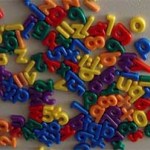Developmental Psychology
A recent paper from the Journal of Adolescent and Adult Literacy came across my desktop yesterday called e-Reading and e-Responding: New Tools for the Next Generation of Readers.
In it, Lotta C. Larson describes her observation of 10 fifth-grade students who were given access to an e-reader containing two recent award-winning books, both by Christopher Paul Curtis: Bud, Not Buddy, and The Watsons Go To Birmingham-1963.
She observed that at first they used the e-reader's highlighter function to mark passages that they thought they might be quizzed on. Once they realized they would not be…
What are the cognitive and neural systems that allow us to build buildings, play checkers, do multivariate statistics, receive DVDs by mail, follow Dr. Isis's pesto recipe, or navigate the tangled LA freeways?
You may ask: what can studying children and non-human animals tell us about the complexity of the human experience? Only educated human adults engage with formal mathematics, cooking, or map reading. Right?
This is a reasonable question to ask. But when human adults show complex, possibly culture-specific skills, they emerge from a set of psychological (and thus neural) mechanisms…
I've been busy writing up a new paper, and expect the reviews back on another soon, so ... sorry for the lack of posts. But this should be of interest:
The Dana Foundation has just posted an interview with Terrence Sejnowki about his recent Science paper, "Foundations for a New Science of Learning" (with coauthors Meltzoff, Kuhl & Movellan). Sejnowski is a kind of legendary figure in computational neuroscience, having founded the journal Neural Computation, developed the primary algorithm in independent components analysis (infomax), contrastive hebbian learning, and played an early…
We know that dogs can read human faces, it turns out that babies can infer the meaning of different dog barks:
New research shows babies have a handle on the meaning of different dog barks - despite little or no previous exposure to dogs.
Infants just 6 months old can match the sounds of an angry snarl and a friendly yap to photos of dogs displaying threatening and welcoming body language.
Synaesthesia refers to the phenomenon where certain perceptual stimuli induce an unrelated and illusory perception - for example, a digit-color synaesthete may experience a sensation of the color green whenever exposed to the number 3. The relationships between the inducers and the induced synaesthetic experience are widely considered random; one anecodotal explanation is that letter-color synaesthesia could reflect a childhood memory of the particular colors used inrefrigerator magnet letters.
A recent Current Biology article from Kadosh, Henik and Walsh turns this common wisdom on its…
There's little evidence that "staging" the training of neural networks on language-like input - feeding them part of the problem space initially, and scaling that up as they learn - confers any consistent benefit in terms of their long term learning (as reviewed yesterday).
To summarize that post, early computational demonstrations of the importance of starting small were subsequently cast into doubt by numerous replication failures, with one exception: the importance of starting small is replicable when the training data lack temporal correlations. This leads to slow learning of the…
The ability to suppress unwanted thoughts and actions is thought (by some) to be crucial in your ability to control behavior. However, alternative perspectives suggest that this emphasis on suppression or "inhibition" is misplaced. These perspectives, largely motivated by computational models of the brain, suggest that alternative abilities (such as the activation or "active maintenance" of wanted thoughts and actions) are the real underlying mechanisms of inhibition and suppression.
This debate is given new life by the emerging science of "executive function training," which carefully…
In an update to their groundbreaking earlier demonstration that high-IQ children initially show a thinner cortex, and later show an initially thicker one than their average-IQ peers, Shaw et al. have now documented those trajectories of cortical thickening which are invariant to socio-economic status and IQ, but vary between regions of the brain. These videos show the peak in gray matter in cortex between the ages of 5 and 15 years, as assessed from magnetic resonance imaging (MRI) of 375 subjects of varying ages.
And another video below the fold...
Dark red areas indicate those…
If you said 1/1000, you've given the answer provided more often by second graders than by undergraduates. And you're also right.
Evidence from functional neuroimaging and developmental psychology indicate that the human brain possesses an abstract system for magnitude comparison, perhaps relying on the intraparietal sulcus of the posterior parietal cortex. One "feature" of this system is that it follow's Weber's Law - larger quantities are less discriminable from one another than smaller quantities. Thus, in this part of the brain numerical representations are not linear but logarithmic.…
My friend Geoff once said that "all cognition is social." Smugly, I reminded myself that the conclusions of cognitive psychologists are drawn on evidence where social cues are kept constant. But even in the absence of confounding social cues, perhaps the underlying cognitive processes themselves are caused by social factors.
A great example of this comes from today's issue of Science, in which Topal et al describe how a well known "cognitive" phenomenon - perseveration - may be dramatically influenced by social cues.
Topel et al focus on a situation in which very young infants will…
Visual perception is constantly challenged by visual occlusion: objects in our environment constantly obscure one another, and seem to "disappear" when in fact they are nonetheless present.
Young infants begin to demonstrate a basic understanding of "object permanence" at some point during the first six months of life. On more complex tasks, understanding of object permanence is not observed until months later, as in Piaget's A-Not-B task. Even in these more demanding tasks, however, some understanding of object permanence can be revealed by the direction in which children gaze: kids will…
Parietal cortex is critical for the maintenance of object information over delays. This is true both in tests of working memory (e.g., 1, 2 and 3) as well as simple visual manipulations involving the occlusion of visible objects.
A great example is this study by Olson et al., who demonstrated that neurons in human intraparietal sulcus (IPS) and middle temporal (MT) cortex increased their activity in response to objects which disappeared due to occlusion (i.e., they were hidden behind another object) relative to those which simply disappeared without an occluder. This was particularly…
To enhance any system, one first needs to identify its capacity-limiting factor(s). Human cognition is a highly complex and multiply constrained system, consisting of both independent and interdependent capacity-limitations. These "bottlenecks" in cognition are reviewed below as a coherent framework for understanding the plethora of cognitive training paradigms which are currently associated with enhancements of working memory, executive function and fluid intelligence (1,2, 3, 4, 5, 6, 7, 8, 9,
10, c.f. 11, 12, 13).
By far, the most common complaint about limitations in cognition is…
How would an ideal behavioral method for cognitive enhancement actually affect the brain? Perhaps cognitive enhancement would be accompanied by more activity in the prefrontal cortex, indicating more successful engagement of control - or perhaps by less, indicating more efficient processing? Perhaps it would be accompanied by a transition from prefrontal activation to parietal activation, suggesting more automatic processing of task information. Perhaps it would make representations in prefrontal cortex more abstract and generalizable, or perhaps it would cause representations there to…
Kevin at IQ's Corner has blogged about a new paper in PNAS showing that "working memory" training can improve measures of fluid intelligence - a capacity long thought to be relatively insensitive to experience, and intricately tied to the most complex human cognitions like reasoning, planning, and abstraction in novel contexts.
Jaeggi et al., posit that no empirical evidence shows "computer games enhance anything beyond task-specific performance and selective visuospatial attention" (which must bother our friends at Lumosity & SharpBrains - sigh), and highlight the concern that by "…
Children can be notoriously constrained to the present, but a fascinating article in JEP:HPP by Vallesi & Shallice shows exactly how strong that constraint can be: in a study with 4-11 year-olds, they show that only children older than about 5 years will take advantage of additional time provided for them to prepare for a simple task.
Among adults, this finding is part of the literature on "foreperiod phenomena." Classically, this refers to the finding that reaction times are disproportionately faster with longer intervals between a warning stimulus and an "imperative" stimulus (e.g…
New research from Wharton and the Carlson School shows that a methodologically-appealing measure of impulsivity - hyperbolic discounting rate - may actually reflect a systematic "skew" in the way people perceive time.
Previous work has shown that people tend to decreasingly discount the usefulness or appeal of a reward with increasing delays; that is, a reward provided now is more appealing than a reward provided 1 week or 1 month from now, but that change in appeal is nonlinear (hyperbolic) across time. In other words, people prefer to behave impatiently now, but prefer to act more and…
Does the resolution or precision of human memory change with its available capacity? In other words, can you remember fewer items with greater precision than you can remember more items?
Contradicting intuition, a new paper from yesterday's issue of Nature shows that all items are stored in memory with equal resolution, regardless of the number of items stored. Authors Zhang & Luck first showed that subjects are equally accurate in reporting the color of a memorized item regardless of the number of other items being maintained in memory. Specifically, when subjects were asked to…
Almost everyone tries to lose weight at some point, but we are remarkably bad at it; most people quickly return to their original weight after cessation of exercise or resumption of a normal diet. A review article by Patterson & Levin elucidates the pathways for this effect, and in the process finds a special role for juvenile exercise in guarding against obesity throughout the lifespan.
Patterson & Levin review several reasons for why it's so difficult to lose weight. First, caloric restriction is associated with subsequent "compensatory" increases in food intake, in both humans…
We often assume that true understanding is conveyed through spoken speech rather than gesture, but new research shows that "talking with your hands" can not only reveal different information than spoken language, it can be both more correct and yield better learning.
Goldin-Meadow and colleagues have previously shown that spontaneous gesture during speech contains a form of implicit knowledge - knowledge that cannot be verbally reported, but nonetheless affects performance. Similar phenomena are known as knowledge-action dissociations; for example, in Piagetian conservation tasks, children…

